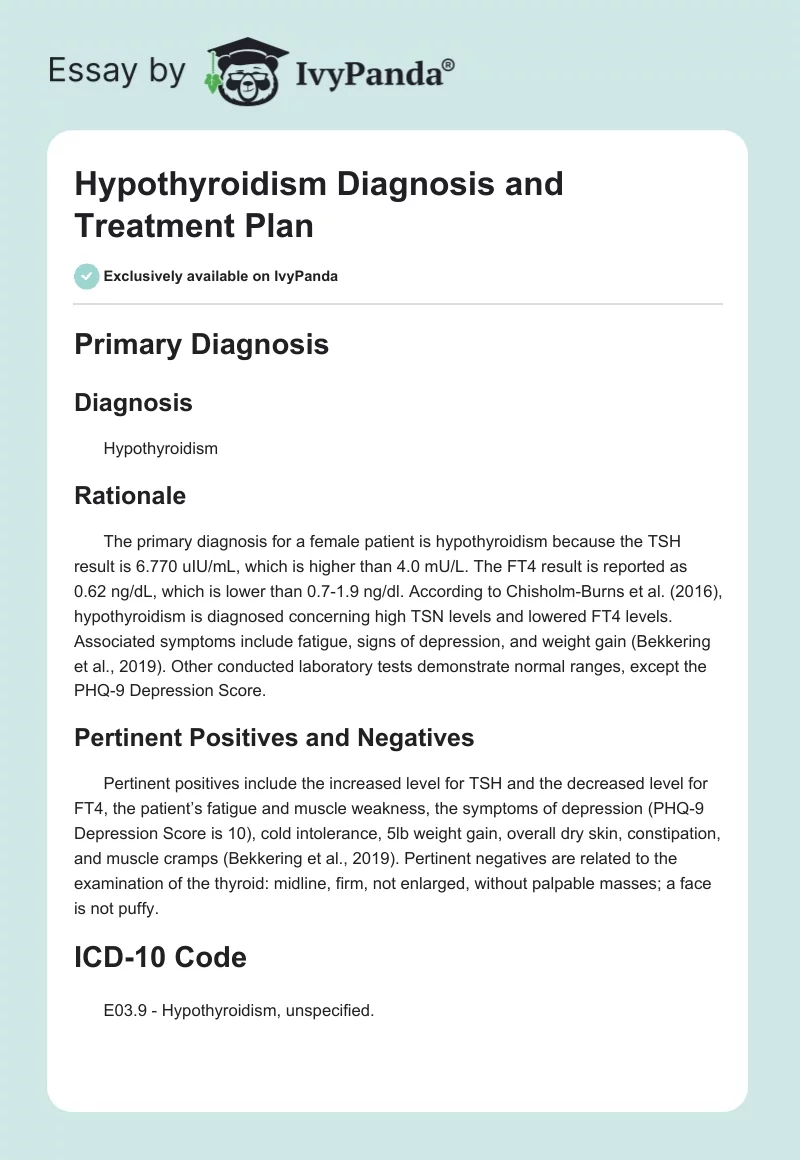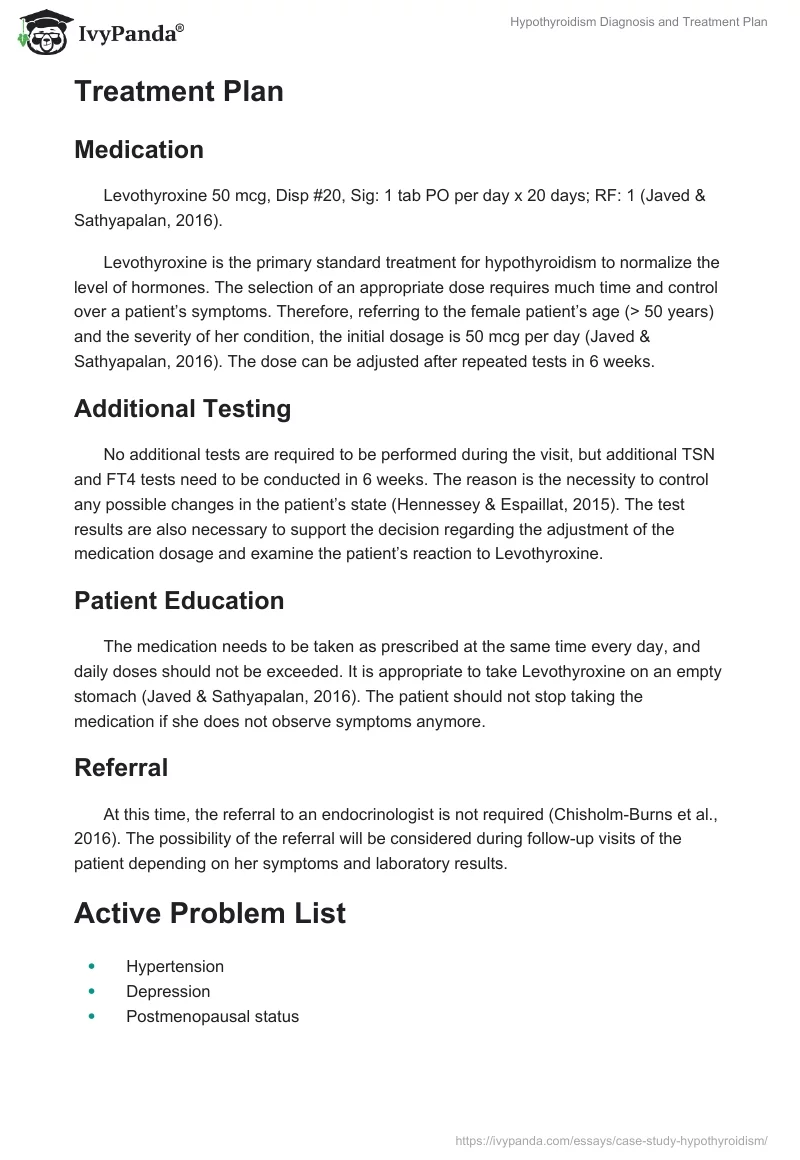Primary Diagnosis
Diagnosis
Hypothyroidism
Rationale
The primary diagnosis for a female patient is hypothyroidism because the TSH result is 6.770 uIU/mL, which is higher than 4.0 mU/L. The FT4 result is reported as 0.62 ng/dL, which is lower than 0.7-1.9 ng/dl. According to Chisholm-Burns et al. (2016), hypothyroidism is diagnosed concerning high TSN levels and lowered FT4 levels. Associated symptoms include fatigue, signs of depression, and weight gain (Bekkering et al., 2019). Other conducted laboratory tests demonstrate normal ranges, except the PHQ-9 Depression Score.
Pertinent Positives and Negatives
Pertinent positives include the increased level for TSH and the decreased level for FT4, the patient’s fatigue and muscle weakness, the symptoms of depression (PHQ-9 Depression Score is 10), cold intolerance, 5lb weight gain, overall dry skin, constipation, and muscle cramps (Bekkering et al., 2019). Pertinent negatives are related to the examination of the thyroid: midline, firm, not enlarged, without palpable masses; a face is not puffy.
ICD-10 Code
E03.9 – Hypothyroidism, unspecified.
Treatment Plan
Medication
Levothyroxine 50 mcg, Disp #20, Sig: 1 tab PO per day x 20 days; RF: 1 (Javed & Sathyapalan, 2016).
Levothyroxine is the primary standard treatment for hypothyroidism to normalize the level of hormones. The selection of an appropriate dose requires much time and control over a patient’s symptoms. Therefore, referring to the female patient’s age (> 50 years) and the severity of her condition, the initial dosage is 50 mcg per day (Javed & Sathyapalan, 2016). The dose can be adjusted after repeated tests in 6 weeks.
Additional Testing
No additional tests are required to be performed during the visit, but additional TSN and FT4 tests need to be conducted in 6 weeks. The reason is the necessity to control any possible changes in the patient’s state (Hennessey & Espaillat, 2015). The test results are also necessary to support the decision regarding the adjustment of the medication dosage and examine the patient’s reaction to Levothyroxine.
Patient Education
The medication needs to be taken as prescribed at the same time every day, and daily doses should not be exceeded. It is appropriate to take Levothyroxine on an empty stomach (Javed & Sathyapalan, 2016). The patient should not stop taking the medication if she does not observe symptoms anymore.
Referral
At this time, the referral to an endocrinologist is not required (Chisholm-Burns et al., 2016). The possibility of the referral will be considered during follow-up visits of the patient depending on her symptoms and laboratory results.
Active Problem List
- Hypertension
- Depression
- Postmenopausal status
Changes
The patient has the symptoms of hypertension and depression that may be associated with hypothyroidism (Chisholm-Burns et al., 2016). Adjustments in the dosage of such medicines taken by the patient as Prozac and Bisoprolol are not required till receiving data on the patient’s progress after taking Levothyroxine. The reason is that the symptoms of depression make become milder as a result of the therapy. The following regimen should be followed:
Prozac 20mg, Disp#20, Sig 1 tab PO per day, Refill: 1 (Chisholm-Burns et al., 2016).
Bisoprolol-HCTZ 2.5mg/6.25mg, Disp#30, Sig 1 tab PO per day, Refill: 1 (Chisholm-Burns et al., 2016).
Follow-Up Plan
The patient should be asked to visit the practitioner in 6 weeks to examine the TSH level. Following Chisholm-Burns et al. (2016), TSN levels are measured 4-8 weeks after starting to take Levothyroxine. If the patient experiences worsening symptoms, she should visit the practitioner in 4 weeks. Then, TSN levels will be measured again in 6 months (Javed & Sathyapalan, 2016). The PHQ-9 Depression Score should be measured in 6 weeks after the prescription of Levothyroxine to decide on the dose of Prozac.
References
Bekkering, G. E., Agoritsas, T., Lytvyn, L., Heen, A. F., Feller, M., Moutzouri, E.,… Farhoumand, P. D. (2019). Thyroid hormones treatment for subclinical hypothyroidism: A clinical practice guideline. BMJ, 365. Web.
Chisholm-Burns, M. A., Schwinghammer, T. L., Malone, P. M., Kolesar, J. M., Lee, K. C., & Bookstaver, P. B. (2016). Pharmacotherapy principles and practice (5th ed.). New York, NY: McGraw-Hill.
Hennessey, J. V., & Espaillat, R. (2015). Diagnosis and management of subclinical hypothyroidism in elderly adults: A review of the literature. Journal of the American Geriatrics Society, 63(8), 1663-1673.
Javed, Z., & Sathyapalan, T. (2016). Levothyroxine treatment of mild subclinical hypothyroidism: A review of potential risks and benefits. Therapeutic Advances in Endocrinology and Metabolism, 7(1), 12-23.


